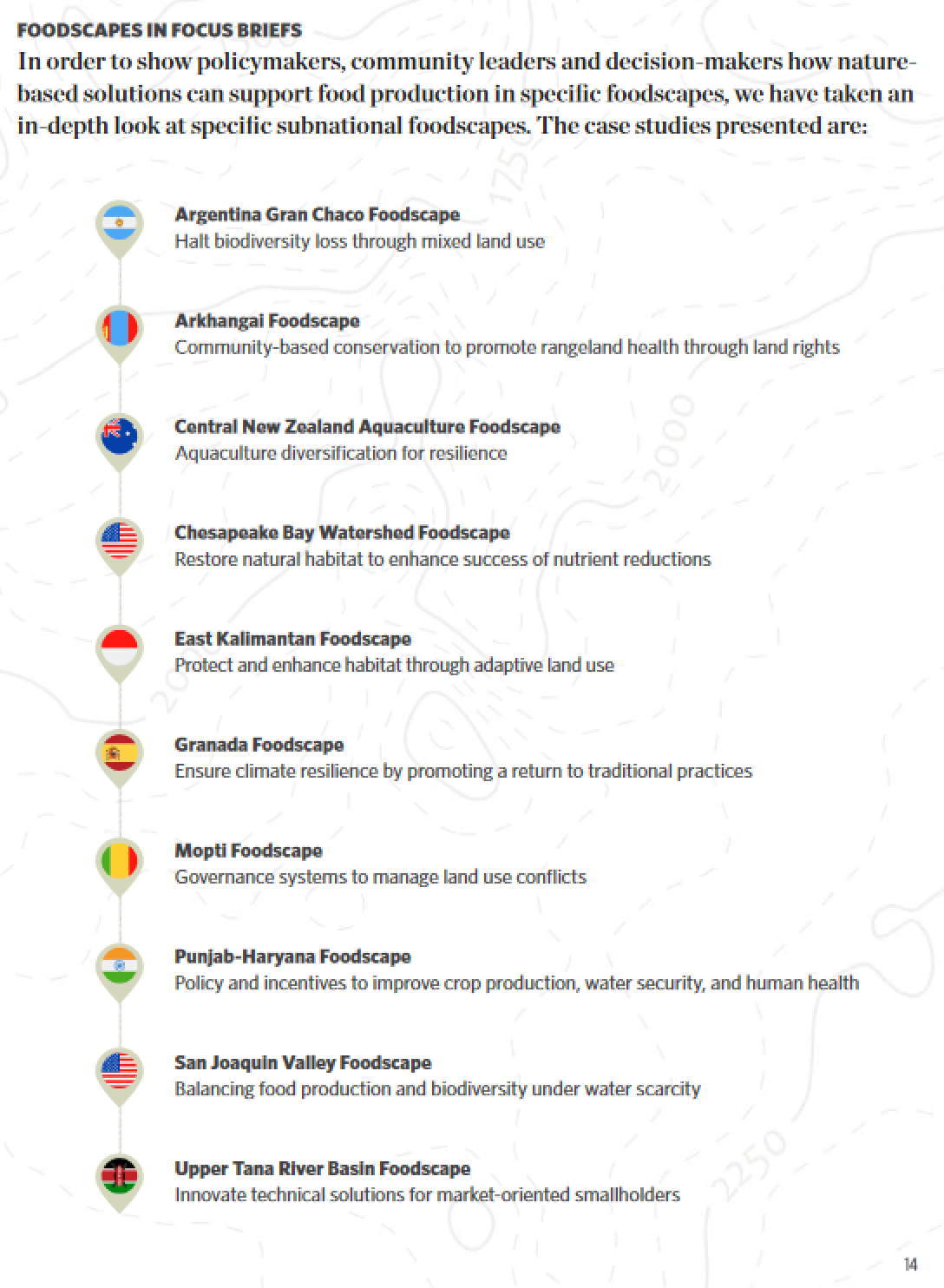Foodscapes are the geographical components of the global food system, a combination of production system and place that represents the world food system spatially.
The report maps the world's foodscapes and assesses their current condition. It looks at the threats they face, and the opportunities that exist through nature-based solutions to transition to a food system able to meet demand while conserving biodiversity, rebuilding ecosystem services, mitigating climate change and increasing the resilience necessary to weather climate change impacts.
The report includes examination of what the transition could look like in 10 specific foodscapes.
Key findings
-
Global carbon benefit on croplands and grazing lands ranging from 2.2 up to 3.3 GtCO2 y-1 through restoration; 4.4 up to 14.6 GtCO2 y-1 through agroforestry; and 2.2 up to 5.0 GtCO2 y-1 through improved soil health practices;
-
Global habitat restored on up to 428 million hectares of crop and grazing lands and up to 1267 million hectares of habitat-friendly farming;
-
Increase of edible food from sea of between 36-74% by 2050 through improved management of wild fisheries and restorative aquaculture;
-
Reduction of 15% in water removals for agriculture; and
-
Reduction of almost 50% in synthetic nitrogen fertilizer use, through nutrient management and substitution with organic sources.
A NECESSARY TRANSITION
The world food system employs 1 billion people and accounts for about 10% of global GDP. It also accounts for up to 35% of global emissions and is the biggest single driver of biodiversity and habitat loss. Food production systems have intensified, but sustainable intensification has been the exception, not the rule. Intensification has meant greater pressure on soils, more biodiversity loss, increased agrochemical and fertilizer use and higher emissions.
Climate change can lead to lower yields and threatens to destabilize production systems at exactly the moment when rapidly rising demand puts more stress on those systems. Change is coming. It will either come as economic and social disruption, or as part of a managed transformation.
At the heart of the transformation should be a focus on rethinking and regenerating the individual foodscapes that underpin the global food system. The transition makes economic as well as environmental sense: the hidden costs of the current world food system are estimated at $12 trillion, $2 trillion more than the system generates.
FOODSCAPES: A SPATIAL ANALYSIS
A foodscape is a terrestrial or aquatic food production area defined by a series of distinct biophysical attributes and management patterns, which can be mapped. They cover all parts of the globe where food is produced. When mapped, they form a mosaic at the subnational level around the world.
This report presents the results of the first global analysis and mapping of foodscapes. Some foodscapes occur in relatively small, confined areas while others are widespread and occur on multiple continents. Examples of the latter include semi-arid grazing systems that are widespread on all continents, and “breadbasket” foodscapes with intensive grain and oil crop production in temperate plains with good soils. As is to be expected, foodscapes are very diverse, and the global mapping resulted in more than 80 foodscape classes.
Defining and mapping foodscapes makes it easier to envision which nature-based solutions are most relevant to the transition the foodscape will need to make to accommodate demand, conserve ecosystems and the services they provide, and mitigate greenhouse gas emissions.
Global level transitions are often hard to translate into local context: the solutions are too abstract, too removed from economic and political realities.
Any analysis of this type faces challenges. Marine data is not as comprehensive as terrestrial data and lacks attributes enabling detailed mapping at a sub-national or sub-regional level.
A CALL TO ACTION
This report suffers from the gaps and omissions inevitable in any effort to conduct a global-level spatial analysis, and is also a call to action to the research community, civil society and policymakers to move further and faster on addressing these omissions.
It is also a call for a policy response proportionate to the challenge. There is growing consensus on the high-level changes necessary in the global food system. Now it is urgent that we proceed to the next step: detailed planning and implementing of food system transition at national and subnational scales. We need policy frameworks and market incentives to get behind that transition, moving beyond the inertia of business as usual and vested interests.

| Year of publication | |
| Publisher | The Nature Conservancy |
| Geographic coverage | SpainMongoliaNew ZealandUnited StatesArgentinaMaliKenyaIndonesiaIndiaGlobal |
| Originally published | 22 Dec 2021 |
| Knowledge service | Metadata | Global Food and Nutrition Security | AgroecologyFisheries and aquaculture and food and nutrition securitySustainable Food Systems | Food systems transformationFertilizerAgroforestryNature-based solutionSoil degradationWater management |
| Digital Europa Thesaurus (DET) | geographical information systembiodiversityland useClimate change mitigation |
